The Bereishit Dance Company from South Korea performs at the Jacob’s Pillow Dance Festival.
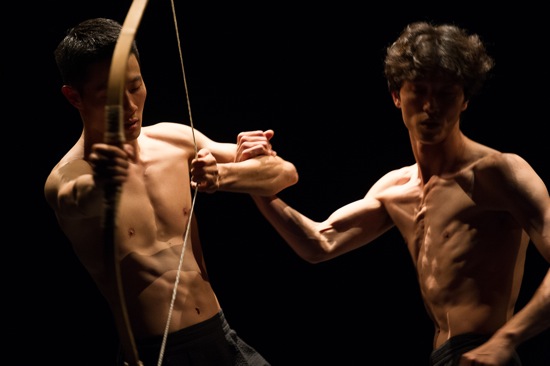
Jae-wu Jung (L) and Cheol-in Jeong in Soon-ho Park’s Bow. Photo: Christopher Duggan
I have long been an admirer of Korean traditional dance. When singer Seo-hee Lee walked into Jacob’s Pillow’s Doris Duke Studio Theater, she was wearing a billowing white and pink hanbok. Dong-sik Lim and Sung-gun Park, the other two musicians preparing to accompany Seoul’s Bereishit Dance Company’s performance of Balance and Imbalance (2010) also wore traditional attire: long coats over white breeches. But having already seen the program opener, Bow, I knew better what to expect and what to be surprised by.
The much-awarded company’s artistic director and choreographer, Soon-ho Park, honors his heritage, but keeps his eyes open to what’s going on in his own culture and others. Like all five of the dancers who accompanied him to Becket, he graduated from Hansung University in Seoul, where he studied “contemporary dance,” but he also continued his education in the Netherlands and worked with companies in Europe before founding the well-travelled Bereishit in 2000. You can try digging into his style, glimpsing here and there allusions to contact improvisation, martial arts, ritual, acrobatics, hip-hop, even gangnam style, but whatever the sources may be, the choreography he has created for his company has a distinctive look.
The tremendously skilled and focused dancers approach many of their movements as if these were tasks to be appraised and tested. Their rhythms are full of pauses, and they explore the contrast between slow, drawn-out moments and slashes of dancing so rapid that you can’t be sure what you’ve seen. Watchful and alert; they seem always ready to join, help, or obstruct one another.
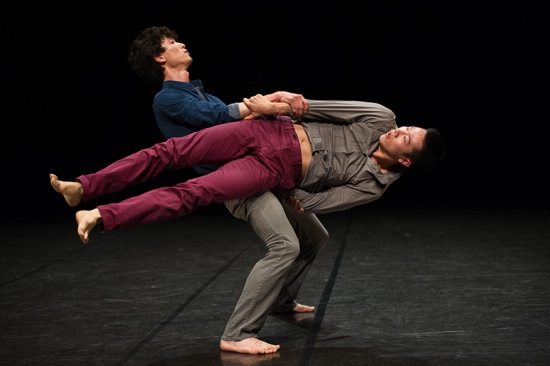
Cheol-in Jeong supporting Jae-wu Jung in Soon-ho Park’s Balance and Imbalance. Photo: Christopher Duggan
Bow (2014) isn’t titled after an obeisance; it refers to the bow that shoots arrows. The program note explains that the two performers “recreate the act of making and firing a bow, turning these actions into an austere confrontation with oneself.” The choreography refers to traditional Korean archery, in which sport and meditation combine. I see the duet, too, as an investigation; the men design complex situations on which they can build or from which they can free themselves.
Jae-woo Jung is alone onstage with the bow when the piece begins. If he is supposed to be “making” it, that act is intensely stylized. In silence, he wraps its string around his wrist, passes it through his teeth, and guides it—now over the top of his head, now around his foot. When he touches it to his chest, he caves in as if struck. Every move he makes is considered. Perhaps he’s measuring the bow to fit it to himself in ingeniously symbolic ways. The first sound we hear is the low moan it emits when he pushes it across the floor on one of its wooden ends.
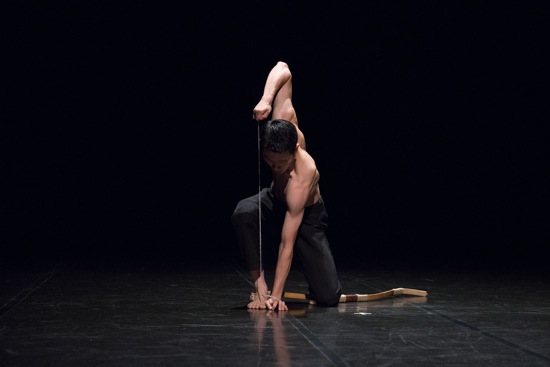
Jae-woo Jung in Bow. Photo: Christopher Duggan
For all dance’s vaunted “universality,” I feel at times as if I’m deciphering a foreign language. When Cheol-in Jeong walks in and appraises the situation, he removes the string that’s in Jung’s mouth again. Jung then steps on the toe of Jeong’s bright-striped sock, which incites Jeong to pull his leg slowly away from that impedance until his foot is free from the elongating sock, which has become as taut as a bowstring.. Do we laugh? Some of us are unsure. . . . Jung also puts Jeong through smooth maneuvers with the latter’s lightweight, long-sleeved sweater—slipping it off him, sliding him back into it. Jeong complies or initiates changes. Again, the theme seems to be one of measuring and fitting together components. And as the music (by Luduvico Einardi) enters with a loud twang, some slick byplay with the rope creates an illusion that one man’s head can be pulled to the side, puppet-like when the other’s fingers pull the string.
The least interesting part of this very intriguing work comes when the bow is finally bent and strung and the two men, grasping it, pull against each other to stretch the it, duck under it, or swing it overhead to create evolving images of contest and camaraderie. The music during this section provides a three-four rhythm with a heavy beat.
There is no arrow, and no one gets shot, although the last thing we see is Jung standing close to the audience with his back toward us. Jeong at the back of the space, barely visible in Seong-heon Lee’s dimming light, has drawn the bow and is aiming it at his colleague.
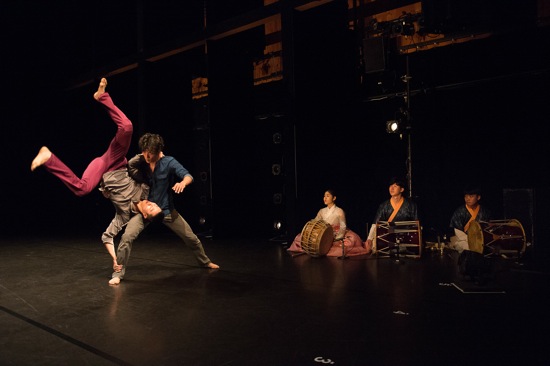
Balance and Imbalance. Jae-woo Jun (upended) with Cheol-in Jeong. At back (L to R): Seo-hee Lee, Dong-sik Lim, and Sung-gun Park. Photo: Christopher Duggan
The fascinating Balance and Imbalance heightens my sense of being a foreigner in an artistic land that I don’t fully understand. The program note, for instance, informs us that, “a master of ceremonies bellows orders. People follow these orders—or not.” I can only assume that “master of ceremonies” refers to Seo-hee Lee, who sings one of the five extant narratives in the bold, pansori style of traditional music. The tale printed in the program tells of an ailing king of the sea. The remedy? Eat a rabbit’s liver. A tortoise lures a rabbit to the underwater palace with promises of food and other rewards. Realizing that death is imminent, the rabbit gets very smart; since many people crave his liver, he says, he routinely takes it out and hides it behind a rock. So, can he go back and get it for the king? You can guess the happy ending (at least for the bunny).
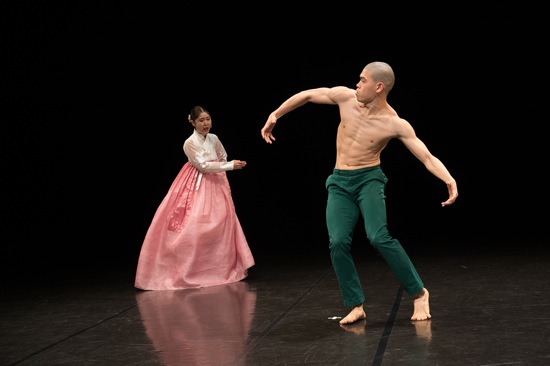
Seo-hee Lee addressing Ji-soo Ryu in Balance and Imbalance. Photo: Christopher Duggan.
Trying to reconcile what seems to be conflicting information is unproductive, although I can interpret one passage in Balance and Imbalance as orders being given, as well as commentary; the singer walks from her seat at the side to the center of the stage and speaks commandingly to us and to the company’s third male performer, Ji-soo Ryu. She also claps and gets us to clap along with her. Ryu flexes his muscles and puffs himself up, but he has trouble maintaining this prideful display of strength and has to keep re-booting his energy—shrugging himself into erectness, even though he feels more like collapsing.
Very little that happens hints at a story, although you might be tempted to attribute one to the moment when Jung and Jeong, who have begun the dance with a handshake, lie on their backs side by side in a possibly ritualistic way, while the singer, seated again, belts out her vocals and the percussionists whip up some especially complex rhythms. Then the men wake up and start dancing again.
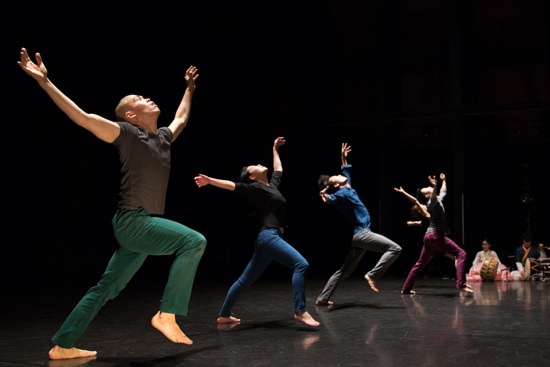
Balance and Imbalance. (L to R): Ji-soo Ryu , So-yeon Kim, Cheol-in Jeong, Jae-woo Jung, Da-som Lee (hidden), and musicians. Photo: Christopher Duggan
Balance and Imbalance doesn’t involve just the three male dancers; they are joined by two women: Da-som Lee and So-yeon Kim. In one striking and enigmatic moment, Lee and Kim are carried forward; the positions they assume in the arms of their bearers make them look like dolls or statues. That’s their only dependent moment.
At some point, I stop wondering about top-value livers and trickster rabbits and relish the resonant physical complexities that Park has devised. With almost no preparations, dancers not only flip into new encounters, they fasten themselves onto one another by angling their bodies and limbs (look, no hands); so you see a construction made of three hooked-together humans, maybe four. An elbow clamps over someone’s shoulder, a torso fits in the crease between anther’s hips and thighs; almost every body part can become an anchorage, a lever, a brace. With the demeanor of serious workers, the powerful dancers create an array of encounters that tell their own story—one of imagination, collaboration, and contention. They might be building a city of structures that disappear as each new one takes shape; their ghost-images hover in memory.
In the end, the five advance toward us in a line and are then isolated in separate pools of light, reminding us that they are performers and that they are individuals. There’s no doubt about that.
